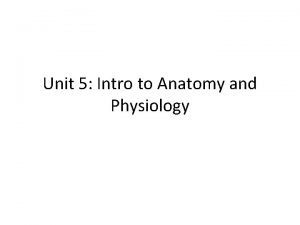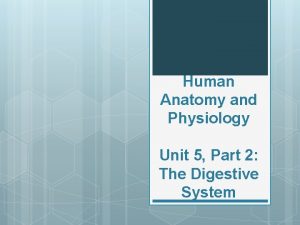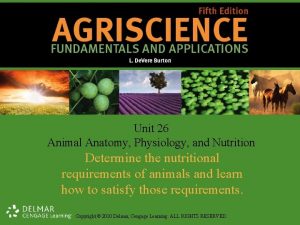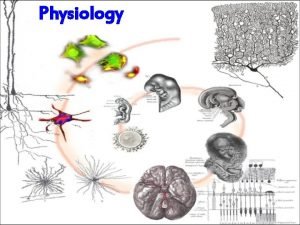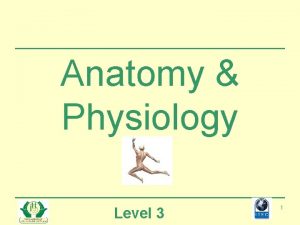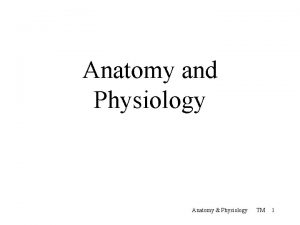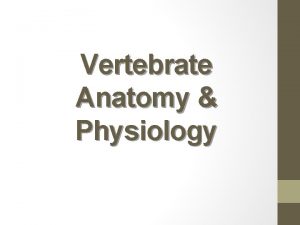Unit 26 Animal Anatomy Physiology and Nutrition Determine





















- Slides: 21

Unit 26 Animal Anatomy, Physiology, and Nutrition Determine the nutritional requirements of animals and learn how to satisfy those requirements. Copyright © 2010 Delmar, Cengage Learning. ALL RIGHTS RESERVED.

Animal Nutrition • Animal nutrition as important as human nutrition • Focus on: – Feed efficiency – Rate of gain – Days to market weight Copyright © 2010 Delmar, Cengage Learning. ALL RIGHTS RESERVED.

Animal Nutrition • Definition of terms – Ration: Amount and content of food eaten by an animal in 1 day – Balanced ration: A 24 -hour ration with needed nutrients in proper proportions and amounts – Deficiency diseases: Diseases that result from improper amounts or balances of vitamins and minerals Copyright © 2010 Delmar, Cengage Learning. ALL RIGHTS RESERVED.

Animal Skeletal System Figure 26 -1 The skeletal system provides support for the body and protection for the soft organs. (Courtesy of IMS, Texas A & M University) Copyright © 2010 Delmar, Cengage Learning. ALL RIGHTS RESERVED.

Animal Muscular System • Figure 26 -2 The welldeveloped muscular system distinguishes meat animals from animals that are raised for other purposes such as milk and wool production. (Courtesy of IMS, Texas A & M University) Copyright © 2010 Delmar, Cengage Learning. ALL RIGHTS RESERVED.

Animal Circulatory System Figure 26 -3 The circulatory system carriers food and oxygen that is dissolved in the blood to all of the cells of the body. (Courtesy of IMS, Texas A & M University) Copyright © 2010 Delmar, Cengage Learning. ALL RIGHTS RESERVED.

Animal Respiratory System Figure 26 -4 The respiratory system provides oxygen to the blood. (Courtesy of IMS, Texas A & M University) Copyright © 2010 Delmar, Cengage Learning. ALL RIGHTS RESERVED.

Animal Nervous System • Figure 26 -5 The nervous system consists of the brain, spinal cord, and the nerves that are distributed throughout the body. This system coordinates all of the other body systems. (Courtesy of IMS, Texas A & M University) Copyright © 2010 Delmar, Cengage Learning. ALL RIGHTS RESERVED.

Animal Urinary System • Figure 26 -6 The urinary system removes waste materials from the blood. (Courtesy of IMS, Texas A & M University) Copyright © 2010 Delmar, Cengage Learning. ALL RIGHTS RESERVED.

Animal Endocrine System • Group of ductless glands that release hormones into the body • Hormones regulate many body activities – – Growth Reproduction Milk production Breathing rate Copyright © 2010 Delmar, Cengage Learning. ALL RIGHTS RESERVED.

Animal Endocrine System • Proper level of nutrients, especially minerals, is crucial to endocrine system functioning Copyright © 2010 Delmar, Cengage Learning. ALL RIGHTS RESERVED.

Ruminant Digestive System in Animals Figure 26 -7 The ruminant digestive system can use large amounts of roughage. (Courtesy of IMS, Texas A & M University) Copyright © 2010 Delmar, Cengage Learning. ALL RIGHTS RESERVED.

Monogastric Digestive System in Animals Figure 26 -8 The monogastric digestive system has a simple stomach. (Courtesy of IMS, Texas A & M University) Copyright © 2010 Delmar, Cengage Learning. ALL RIGHTS RESERVED.

Poultry Digestive System Figure 26 -9 The poultry digestive system has no true stomach, but it does have an organ called the crop, which stores small amounts of feed. (Courtesy of IMS, Texas A & M University) Copyright © 2010 Delmar, Cengage Learning. ALL RIGHTS RESERVED.

Poultry Digestive System Figure 26 -9 It also has a gizzard, which is the organ that grinds the seeds and other materials eaten by birds. (Courtesy of IMS, Texas A & M University) Copyright © 2010 Delmar, Cengage Learning. ALL RIGHTS RESERVED.

Major Classes of Nutrients • • • Water Protein Carbohydrates Minerals Vitamins Fat Copyright © 2010 Delmar, Cengage Learning. ALL RIGHTS RESERVED.

Sources of Nutrients • • Proteins Carbohydrates Fats Vitamins and minerals Copyright © 2010 Delmar, Cengage Learning. ALL RIGHTS RESERVED.

Symptoms of Nutrient Deficiencies • Appropriate types/amounts of feed needed for animals to produce (young or products) • Deficiencies generally produce observable effects Copyright © 2010 Delmar, Cengage Learning. ALL RIGHTS RESERVED.

Feed Composition and Additives • Two main feed components – Water (usually 10 to 20 %) – Dry matter (organic matter and ash or mineral) • Feed additive: Non-nutritive substance added to feed to promote more rapid growth, increase feed efficiency, or maintain or improve health Copyright © 2010 Delmar, Cengage Learning. ALL RIGHTS RESERVED.

Feed Composition and Additives • Two major additive groups – Growth regulators – Antibiotics Copyright © 2010 Delmar, Cengage Learning. ALL RIGHTS RESERVED.

Classification of Feed Materials • Concentrates – Low in fiber, high in total digestible nutrients – Examples: Feed or cereal grains (corn, wheat, oats), grain by-products (wheat bran, brewer’s grain), and animal by-products (tankage, fish meal) • Roughages – High in fiber, low in total digestible nutrients – Three categories: (1) Dry, (2) green, (3) silage Copyright © 2010 Delmar, Cengage Learning. ALL RIGHTS RESERVED.
 Unit 26 self evaluation answers
Unit 26 self evaluation answers Unit 26 animal anatomy physiology and nutrition
Unit 26 animal anatomy physiology and nutrition Anatomy and physiology unit 7 cardiovascular system
Anatomy and physiology unit 7 cardiovascular system Horizontal anatomical plane
Horizontal anatomical plane Physiology of esophagus
Physiology of esophagus Respiratory physiology
Respiratory physiology Tattoo anatomy and physiology
Tattoo anatomy and physiology International anatomy olympiad
International anatomy olympiad Perfect vs imperfect flower
Perfect vs imperfect flower Anatomy and physiology bones
Anatomy and physiology bones Anatomy of peptic ulcer
Anatomy of peptic ulcer Liver anatomy and physiology
Liver anatomy and physiology Podbřišek
Podbřišek Epigastric region
Epigastric region Rbc anatomy and physiology
Rbc anatomy and physiology Chapter 14 anatomy and physiology
Chapter 14 anatomy and physiology 3 layers of muscle
3 layers of muscle Http://anatomy and physiology
Http://anatomy and physiology Waistline
Waistline Physiology of appendix
Physiology of appendix Aohs foundations of anatomy and physiology 1
Aohs foundations of anatomy and physiology 1 Aohs foundations of anatomy and physiology 2
Aohs foundations of anatomy and physiology 2



